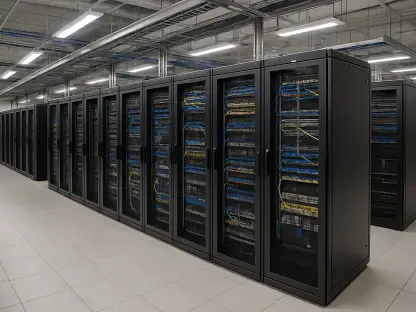Imagine a world where artificial intelligence systems operate autonomously, making real-time decisions across continents without a hiccup, fueled by data processed at the edge rather than in a single, distant hub. This scenario is no longer a distant dream but a pressing reality as AI workloads grow in complexity and scale. Equinix, a global titan in data center solutions, has stepped up to meet this challenge with its Distributed AI Infrastructure, a platform designed to handle the unique demands of modern AI. This review dives deep into the architecture, capabilities, and real-world impact of this innovative solution, exploring how it addresses the critical need for distributed data processing in an AI-driven era.
Core Features and Innovations
Fabric Intelligence: Revolutionizing Connectivity
At the heart of Equinix’s offering lies Fabric Intelligence, a cutting-edge software layer built on the existing Equinix Fabric platform, which facilitates on-demand global interconnection. Set to enhance capabilities starting next year, this feature introduces real-time awareness and automation tailored for AI and multicloud workloads. It tackles persistent issues such as internet congestion, packet loss, and limited throughput, ensuring seamless data flow across diverse environments.
The significance of this technology cannot be overstated. By intelligently routing data through a network of over 270 data centers spanning more than 60 markets worldwide, Fabric Intelligence minimizes latency and maximizes performance. This is particularly vital for enterprises operating in multicloud settings, where disparate data sources must be integrated efficiently to power AI applications without bottlenecks.
AI Ecosystem: A Hub of Collaboration
Equinix has cultivated an expansive AI ecosystem, boasting partnerships with over 2,000 global entities. This network integrates advanced inferencing services like GroqCloud, expected to be accessible through Fabric Intelligence by early next year. Such collaborations enhance the discoverability of AI solutions, enabling enterprises to tap into cutting-edge tools and services with ease.
This ecosystem positions Equinix as a central node for AI innovation. By fostering connections between technology providers and businesses, the platform ensures that enterprises can act swiftly on AI opportunities, leveraging a robust support system to deploy solutions tailored to their needs. The emphasis on partnership underscores a strategic vision to create a collaborative environment for AI advancement.
AI Proving Ground: Testing for Success
Another standout component is the AI Proving Ground, operational at 20 locations across 10 countries through Equinix Solution Validation Centers. This environment serves as a sandbox for enterprises to collaborate with leading AI technology partners, testing solutions in a controlled setting. It offers a critical space to refine innovations before market launch.
The value of this testing ground lies in its ability to mitigate risks associated with AI deployments. By simulating real-world scenarios, companies can identify potential flaws, optimize performance, and accelerate their go-to-market timelines. This facility exemplifies Equinix’s commitment to not just supporting AI but ensuring its reliable and effective implementation across industries.
Performance in Industry Context
The shift from centralized, monolithic data models to distributed, multicloud, and hybrid frameworks is reshaping the tech landscape. AI workloads, in particular, demand low-latency and high-bandwidth connections that the public internet often fails to deliver. As highlighted by Equinix’s Chief Business Officer, Jon Lin, modern enterprises operate in fragmented environments where seamless connectivity is non-negotiable.
Equinix’s infrastructure directly addresses this industry trend by providing a programmable backbone for high-performance AI. The platform’s design prioritizes scalability and efficiency, ensuring that data processing happens closer to the source, reducing delays and enhancing responsiveness. This alignment with current demands positions Equinix as a frontrunner in supporting the next wave of technological evolution.
The broader implications of this shift are evident in how distributed systems enable real-time decision-making for AI applications. From autonomous systems to agentic learning models, the ability to process data across multiple locations without relying on a single hub is transforming operational capabilities for businesses worldwide. Equinix’s solution is a timely response to these evolving needs.
Real-World Impact and Applications
Across various sectors, Equinix’s Distributed AI Infrastructure is proving its worth by powering multicloud and AI-driven operations. Industries such as healthcare, finance, and logistics benefit from the platform’s ability to handle massive data volumes with minimal latency. For instance, real-time analytics for patient monitoring systems can be executed at the edge, improving outcomes through faster insights.
Specific use cases further illustrate the platform’s versatility. Autonomous AI systems, which require instantaneous data processing across global networks, rely on this infrastructure to maintain performance. Similarly, agentic learning models, capable of independent reasoning, leverage the distributed architecture to access and analyze data from diverse sources without delays, driving innovation in automation.
The scalability offered by this solution also enables enterprises to adapt to fluctuating demands. Whether it’s a sudden spike in data processing needs or expansion into new markets, the interconnected network of data centers ensures consistent performance. This adaptability is a game-changer for businesses aiming to stay competitive in a rapidly changing digital landscape.
Challenges in Deployment
Despite its strengths, Equinix’s infrastructure faces notable challenges in maintaining consistent performance across a sprawling global network. Ensuring uniformity in data processing speeds and reliability across different regions is a complex task, particularly when dealing with varying local internet conditions and infrastructure maturity.
Additionally, navigating the intricacies of multicloud environments poses technical hurdles. Integrating disparate systems while maintaining security and compliance with regional regulations adds layers of complexity to deployment. These issues can slow adoption for some enterprises, especially those with limited technical resources to manage such integrations.
Equinix is actively working to address these limitations through continuous improvements to Fabric Intelligence and by strengthening ecosystem partnerships. Efforts to enhance automation and provide tailored solutions for regulatory compliance are underway, aiming to reduce barriers and streamline the adoption process for a broader range of users.
Looking Ahead
The future of Equinix’s Distributed AI Infrastructure holds immense potential as AI technologies continue to evolve. Anticipated advancements include deeper integration with emerging AI tools and further expansion of the global data center network between now and 2027. Such developments could redefine how distributed data processing supports cutting-edge applications.
Industries heavily reliant on AI and multicloud solutions stand to gain significantly from these advancements. Enhanced capabilities could unlock new possibilities in sectors like autonomous transportation and smart manufacturing, where real-time data processing is critical. Equinix’s ongoing investment in scalability and connectivity will likely play a pivotal role in shaping these outcomes.
Moreover, the platform’s adaptability to future tech trends suggests a lasting impact. As AI workloads grow more sophisticated, the need for robust, distributed infrastructure will only intensify. Equinix’s strategic focus on innovation positions it to remain a leader in this space, potentially setting benchmarks for how AI infrastructure evolves over the coming years.
Final Thoughts
Reflecting on this evaluation, Equinix’s Distributed AI Infrastructure emerges as a robust solution that tackles the pressing demands of modern AI through a distributed architecture, intelligent connectivity, and strategic collaborations. Its ability to support complex workloads across a vast network of data centers stands out as a key strength during this analysis. Moving forward, enterprises should consider leveraging this platform to address scalability needs while closely monitoring updates to Fabric Intelligence for enhanced performance. Exploring partnerships within Equinix’s ecosystem could also provide a competitive edge, ensuring access to the latest AI innovations. As the landscape evolves, staying engaged with such infrastructure advancements will be crucial for maintaining agility in an AI-driven future.









